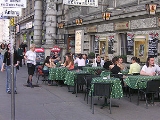
Schanigarten
Encyclopedia
Schanigarten is the Austria
n term for the outside tables set up on the sidewalk in front of a coffeehouse
or other establishment. Originally, the term referred only to Viennese coffeehouses
, but now the expression is used in other parts of Austria and for other types of establishments like bars and restaurants.
Unlike normal Gastgärten (guest areas), the customers actually sit on public property. The first authorization for a Schanigarten was given in 1750 to coffeehouse owner Gianni Tarroni.
The origins of the term are unknown. One thread of speculation believes it stems from Giannis Garten. Another popular tale involves a Schani, an apprentice boy to a waiter, who was told to "Put up the garden!" He then dutifully obeyed the order by carrying chairs, tables and flower boxes outside.
In order to operate a Schanigarten, an establishment needs an authorization, which is valid from March 1 to November 15. The Schanigarten is a very attractive proposition for the owners of an establishment as they only pay a very limited yearly fee of several euros per square meter to the municipality. Operations like ice cream stores can thereby effectively multiply their seating area on public property at minimal cost. An extreme example is the ice cream store Zanoni in the Vienna city center that extends its Schanigarten over three quarters of the adjacent public square and has set up glass separaters to prevent side walk users from crossing the privatized zone.
Furthermore, permissions are also granted to set up Schanigartens not on the sidewalk but on the actual driving lanes or parking lanes, reducing the number of available parking spaces.
Austria
Austria , officially the Republic of Austria , is a landlocked country of roughly 8.4 million people in Central Europe. It is bordered by the Czech Republic and Germany to the north, Slovakia and Hungary to the east, Slovenia and Italy to the south, and Switzerland and Liechtenstein to the...
n term for the outside tables set up on the sidewalk in front of a coffeehouse
Coffeehouse
A coffeehouse or coffee shop is an establishment which primarily serves prepared coffee or other hot beverages. It shares some of the characteristics of a bar, and some of the characteristics of a restaurant, but it is different from a cafeteria. As the name suggests, coffeehouses focus on...
or other establishment. Originally, the term referred only to Viennese coffeehouses
Viennese café
The Viennese Coffee House is a typical institution of Vienna that played an important part shaping Viennese culture.Since October 2011 the "Viennese Coffee House Culture" is listed as "Intangible Cultural Heritage" in the Austrian inventory of the "National Agency for the Intangible Cultural...
, but now the expression is used in other parts of Austria and for other types of establishments like bars and restaurants.
Unlike normal Gastgärten (guest areas), the customers actually sit on public property. The first authorization for a Schanigarten was given in 1750 to coffeehouse owner Gianni Tarroni.
The origins of the term are unknown. One thread of speculation believes it stems from Giannis Garten. Another popular tale involves a Schani, an apprentice boy to a waiter, who was told to "Put up the garden!" He then dutifully obeyed the order by carrying chairs, tables and flower boxes outside.
In order to operate a Schanigarten, an establishment needs an authorization, which is valid from March 1 to November 15. The Schanigarten is a very attractive proposition for the owners of an establishment as they only pay a very limited yearly fee of several euros per square meter to the municipality. Operations like ice cream stores can thereby effectively multiply their seating area on public property at minimal cost. An extreme example is the ice cream store Zanoni in the Vienna city center that extends its Schanigarten over three quarters of the adjacent public square and has set up glass separaters to prevent side walk users from crossing the privatized zone.
Furthermore, permissions are also granted to set up Schanigartens not on the sidewalk but on the actual driving lanes or parking lanes, reducing the number of available parking spaces.

